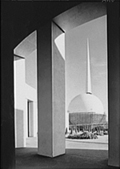
The New York World’s Fair opens. Its World of Tomorrow theme shapes industrial design, pop culture, and the way the future would envision the future.

Buildings were inspired by the pages—and covers—of pulp science fiction: huge geometric shapes, sweeping curves, plenty of glass and chrome, and gleaming white walls. The fair was the last great blossoming of the Streamline Moderne style of Art Deco. It also reflected the International Style of architects like Le Corbusier (see here).
At the fair’s center were the Trylon (a triangular obelisk) and Perisphere, a gigantic sphere accessed by dramatic ramps. Inside was a model city of tomorrow. But the fair’s most memorable exhibit was the Futurama ride in designer Norman Bel Geddes’s General Motors Pavilion. People stood in line for hours to ride it and experience the exciting possibilities of life in the distant future: the year 1960. Futurama carried visitors past tiny, realistic model landscapes while a narrator described the world of tomorrow. The effect was like glimpsing the future from an airplane window. The GM-sponsored ride focused on what roadways and transportation might look like in twenty years.
The ride presented a utopia forged by urban planning. Two decades before the interstate system (see here), model sophisticated highways ran through rural farmland and eventually moved into carefully ordered futuristic cities. Futurama had two factors that compounded the fascination: first, a promise of personal car ownership (and after the Great Depression, that sounded pretty good); and second, a grand overall vision of the future. Until Futurama, manufacturers had exhibited at fairs only to show their current products.
The fair left an indelible imprint on popular culture, visible in everything from the art design in sci-fi films to forward-looking marketing campaigns to the widespread use of the suffix -arama.—CB